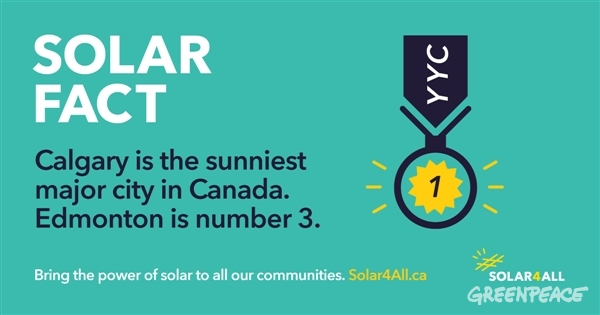This summer, we’re launching a new campaign to bring solar power to all people and communities in Alberta. Solar4All is about going beyond fossil fuels by not only changing where our energy comes from but how it’s owned, distributed, and controlled. Unlike fossil fuels, solar power can be a source of clean, low-cost energy that individuals, communities, farmer associations or First Nations and Metis settlements can own.
Solar power is already taking hold all around the world. To give you an idea of what’s possible we’ve gleaned these 10 solar case studies and facts from around the world to show that powering our lives with solar is not only possible – it’s being done now.
In Alberta, it’s time to catch up and ensure everyone can benefit in the process.

Now without further adieu, our top 10 solar facts:
Solar power is already taking hold all around the world. To give you an idea of what’s possible we’ve gleaned these 10 solar case studies and facts from around the world to show that powering our lives with solar is not only possible – it’s being done now.
In Alberta, it’s time to catch up and ensure everyone can benefit in the process.

Now without further adieu, our top 10 solar facts:
- Germany is surpassing its own solar power goals: Germany’s goal is to generate 35% of its electricity from renewable sources by 2020 and 100% by 2050. To get there, they have encouraged individuals to put solar panels on their homes. It’s working: 90% of the country’s solar panels are on people’s roofs. And what’s even more inspiring is that 47% of all renewable power is owned by citizens and co-ops instead of corporations. On a sunny day in June 2014, Germany s쳮ded in generating more than 50% of its electricity from solar panels. All of this happened in a place that’s not exactly known for it’s sun — German cities average 70 days of sun per year, compared to Alberta’s 300+.
- France is making all new buildings in commercial zones go green or solar: New environmental legislation in France requires rooftops on new buildings in commercial zones to be partially covered either in plans or solar panels. The law will help France catch up with other European countries in taking advantage of solar power.
- Japan is taking solar to the next (sea) level: Japan has the world’s third largest photovoltaic (PV) capacity in the world. But if government residential PV programs and stimulus packages don’t impress, Japan has upped the anti by hosting the world’s first floating solar plant. The plant will be built on reclaimed lands jutting into the water and will produce enough energy to power 22,000 homes.
- Denmark is committed to a fossil-fuel free future: Denmark has pledged to phase out coal completely by 2030. By 2035, Denmark will meet all of it’s energy demands in electricity and heating from renewables, and by 2050, all of Denmark’s energy will come from renewables.
- San Francisco put solar into law: San Francisco made history when it passed legislation requiring solar panels on all new buildings under 10 stories high. The tech hub is now the largest American city to legislate solar.
- The U.S. solar industry employs more people than oil and gas: With 209,000 workers, the U.S. solar industry surpassed oil and gas in 2015. The U.S. Department of Labour put the oil and gas industry’s shrinking workforce at 184,500 in December 2015. The number of jobs in the solar industry has more than doubled in just five years.
- Americans are saving tens of millions with solar: When President Obama said that solar energy was saving Americans tens of millions of dollars per year on their electricity bills, he repeated what the solar industry had been been saying for years. The savings come from approximately one million projects solar projects operating across the US. People with solar panels can reap the savings every year for 30 years.
- Solar is a stable income stream for farmers: Solar companies in the US are paying some farmers more than they can earn growing crops to install solar farms. In a time of uncertainty, solar panels have offered farmers a new and reliable source of income.
- B.C.’s largest solar PV project is at the T’souke First Nation: Leading the charge in community-owned solar in B.C. is the T’souke First Nation, “The Creator provided the resources for us to take care of ourselves.” T’Sou-ke embarked on a journey to become a sustainable solar community in 2008 following a planning process that involved everyone in the community – including children.
- Alberta has a massive potential for solar power: With a generous supply of sunny days and cold temperatures, Alberta’s solar energy potential is huge. A solar PV system in Calgary can generate more electricity than a system in Rio de Janeiro, Sydney or Rome – to name a few. Calgary is the sunniest major city in Canada, and Edmonton ranks in at number 3.
Bring solar to every Albertans and support the Solar4All campaign by signing the petition at solar4all.ca.

Discussion
this helped a lot thank you for this information :)